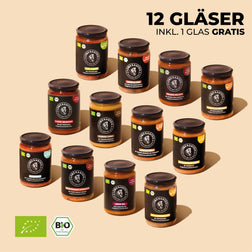Drop the pod... Chickpea!
We love them in Indian dishes. And as a source of protein in a vegan diet. And as a falafel. And as hummus. And as…
Chickpeas are no longer just an exotic legume. Gradually, they blossomed into the power balls that we no longer want to do without in everyday eating. It is not for nothing that they are part of the staple foods in many countries!
And rightly so. Because chickpeas not only taste incredibly delicious, but also score points with a lot of fiber and their versatility.
No wonder we can't get enough of them... Whether as a hearty stew, crunchy side dish or spicy hummus: the chickpeas can!
What are chickpeas anyway?
Contrary to what the name might suggest, chickpeas are not related to peas. While they are both legumes, peas are typically used more like a vegetable, while chickpeas can be cooked, made into hummus or falafel.

“Giggle” comes from the Latin “cicer” which means “pea”. In Old High German they were called “Kihhira” – a term that eventually became our “giggle”. Ergo, chickpea means “pea pea”.
What is commonly known to us as chickpeas also has other names: real chickpeas, Roman chickpeas, Venus chickpeas or field peas. It is a plant species within the legume family.
You can read here what exactly distinguishes legumes and which ones are still available. In a nutshell: as the name suggests, they grow in a pod, their husk. They are dried seeds.
Chickpeas themselves are found in about 3 cm large greenish legumes. Once harvested, the dry seeds can be kept for up to five years. But beware: eating them raw is harmful to your health. Because most legumes contain the toxic lectin and the bitter substance saponin, which must first be boiled in water at a temperature of at least 70 degrees. But you do n't have to worry about our chickpea curry : the chickpeas are already cooked and only need to be heated in the microwave or pot for three minutes.

Chickpeas are mainly grown in subtropical regions around the world: They need little water, are not cold-resistant and like it warm. India and Turkey are leaders in cultivation. But also Mexico, Africa or Afghanistan use their climatic conditions for the cultivation of the power balls.
Basically, we distinguish between several varieties of chickpeas. Two of them are best for cooking:
- Kabuli: they are mainly grown in the Mediterranean area, North Africa and Afghanistan. They usually have light-colored seeds with a thin shell and are sold in our supermarkets. They taste slightly nutty and mild.
- Desi: are usually unknown to us. They are chickpeas that have smaller, darker seeds with a rough skin. These are mainly found in India.
By the way: The chickpea is one of the oldest cultivated plants in the world. It was discovered in the Near East 8,000 years ago. From there she made it across the Middle East to the Mediterranean and India. It is now also grown in Greece and Italy.
What can the chickpea do?
Chickpeas are not so popular for nothing. Not only we and our pride of lions love to use them as a source of protein - they are also absolutely essential in Indian or Lebanese dishes.
One of the reasons for this: They are cheap to grow and harvest and grow very well in warm, not too dry areas. Nevertheless, climate change could result in crop failures and consequently higher prices in the future. Which would harm poorer regions of the world, where chickpeas are an important source of protein.

Nevertheless, chickpeas have some other advantages that should not be underestimated. For example, did you know that chickpeas, like other legumes, reduce the risk of suffering from chronic degenerative diseases? (Source: Adé vegan cliché, Niko Rittenau, p. 283)
Another benefit: chickpeas are very good for muscle growth. With 8 g protein / 100 g, they have long been a real (secret) tip, and not just for vegans. Since almost 22% of the calories chickpeas have come from protein, they're ideal for your post-workout meal. The power balls are not exactly low in calories at 91 kcal / 100 g - but for the amount of protein you get, the calories are definitely worth it.
Important: They are also rich in the two essential amino acids lysine and threonine. These are needed to build proteins and cannot be made by the body itself.
Chickpeas also keep you full for an incredibly long time. The reason? fiber. The long-chain carbohydrates are mainly found in legumes and ensure that we don't get any food cravings. It takes longer to break down the long-chain carbs, so our blood sugar levels neither rise nor fall rapidly. One of the reasons we use legumes as the basis for all of our Löwenanteil dishes .

But chickpeas not only provide a good amount of protein and fiber, they are also an excellent source of important trace elements:
The superfood is also a super source of iron, for example: the pre-cooked chickpeas, with approx. 2.7 mg per 100 g, are not on the same level as, for example, pumpkin seeds (12.5 mg / 100 g), but they are impressive. Dried chickpeas contain even more iron, around 6 mg/100 g. Vegans in particular benefit from the increased iron content and thus strengthen their oxygen transport, immune and brain function. (Goodbye vegan cliché, p. 150)
With 1.2 mg of zinc per 100 g, we support the metabolism and immune system and help with allergies. 125 mg magnesium per 100 g also help our nerve and muscle cells as well as heart activity.
And if even that isn't enough for you, put chickpeas on your plate at your next meal - how about this: They also offer 2.7 mg / 100 g of vitamin E. This is an antioxidant that has an anti-inflammatory effect and also stimulates our immune system. In this way, free radicals that can damage cells are destroyed.

How to prepare chickpeas
If you decide to buy dried chickpeas, you have to plan some time. While they are considered more nutritious than canned, already cooked, they must first be soaked for at least 12 hours. It is best to pour twice the amount of water over them and make sure that they are always covered - they absorb a lot of liquid.
After soaking, discard the soaking water to remove residual toxins, and drain under the faucet again.
You can then cook them, which again takes up to an hour. Depending on whether you need them for a crunchy salad or want to make creamy hummus, the cooking time may vary.

By the way: If you tend to have unpleasant flatulence, simply add 0.5 - 1 g of baking soda to the boiling water. In this way, tolerability is improved.
On the other hand, if you want it to be quick, you can use canned chickpeas. They have similarly good nutritional values (besides the vegan cliché, p. 283) and do not have to be boiled again, just washed off.
Chickpeas spice up every plate with their high protein content and pleasantly mild, nutty taste. Stews are always a good choice.
For example, you can add chickpeas to fried onions, deglaze with vegetable broth and tomato paste and maybe add some lentils - et voilà: you have a quick, protein-rich meal.
But more in the mood for a creamy dip? Then add a can of chickpeas to a blender along with olive oil, lime juice, and garlic. Taste the whole thing with spices (chilli, salt, pepper) and enjoy! Either on bread or in combination with crunchy vegetables.
The legumes are also very suitable for homemade veggie patties. Mix them with flour, vegetables of your choice (e.g. broccoli), some cornstarch and spices until a medium-firm dough is formed. Form into patties and fry them in a skillet over medium-high heat.
As you can see, there are several preparation options. Chickpeas also go well with curry. Would you like to convince yourself? Then feel free to try our vegan chickpea curry – without soaking or cooking.

Conclusion
You haven't tried chickpeas yet? Then it's time! It doesn't matter whether you prefer it firm to the bite or smooth - the power balls have something up their sleeve for everyone. They enrich every dish not only with their taste, but also with proteins, fiber, antioxidants, trace elements...
Falafel, curry and co. - here we come!




